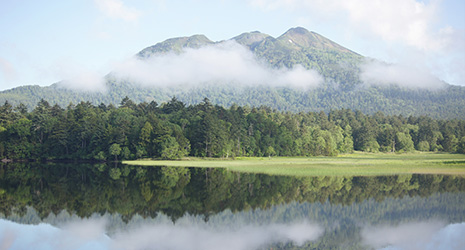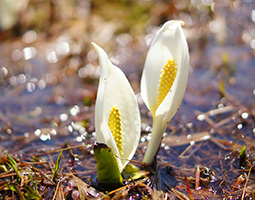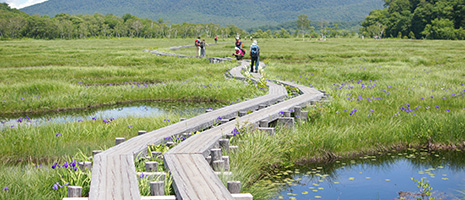April 2020
The Beauty of Oze Preserved

Oze National Park and its beautiful marshland has overcome a variety of environmental challenges thanks to the support of many people.
From mid-May to mid-October, beautiful landscapes filled with blossoming alpine plants can be enjoyed in Oze National Park. The spectacle is captured in the hit song of the fifties Natsu no Omoide (Memory of the Summer), the popularity of which attracted many visitors to Oze.
Oze National Park extends across prefectural borders, reaching into Gunma, Fukushima, Niigata and Tochigi. Centering in Ozegahara marshland and Lake Ozenuma, the park has the largest mountainous marshland in Honshu, spanning nearly 6 kilometers east and west and 2 kilometers north and south. Mt. Hiuchigatake and Mt. Shibutsu are two among several towering mountains in the area.
Uno Shotaro of the Oze Preservation Foundation says of Oze’s unique characteristics, “Many people may associate Oze with the Ozegahara marshland. Because the annual average temperature is low at around 4°C, dying plants decompose poorly and transform into an accumulation of peat. It is estimated that between 0.7 and 0.8 millimeters of peat accumulate per year. It may have taken a very long time, 6,000–8,000 years, for the layer to have become as thick as it is today.”
Ponds called chito, diverse in size, are dotted around the marshland of Ozegahara, creating a habitat for many creatures. More than 900 species of plants grow in Oze, including the famous mizubasho (lit. water plantains), which rise from the snowmelt in May and June, and kanzou daylilies, which cover the marshland in a yellow-orange blanket in the summer. The flowers bloom successively one after another between mid-May and mid-October. Thanks to the abundant vegetation, the marshes and surrounding forests of Oze are also home to many mammals, birds, amphibians, fish, insects and other creatures. Hikers may spot small creatures such as butterflies, dragonflies, short-tailed weasels, dormice, waterfowl and many other creatures that are rarely seen on flat land.

Despite its great abundance, the nature of Oze has experienced several crises in the past. A project to construct a hydroelectric dam using the abundant water of Oze had been put forward. Another project would have built a large motor road connecting Fukushima and Gunma. However, local residents and researchers voiced their disagreement in an effort to protect the rich nature of Oze. In the end, all the projects were cancelled.
The Oze boom triggered a surge of visitors to Oze who trampled the precious marshland. As a solution to this problem, the construction of wooden paths started in the 1950s and efforts to restore vegetation have continued since then. Around that time, the waste brought by tourists became a serious problem in Oze. It was significantly reduced after a campaign encouraging hikers to take their waste home with them was introduced in the 1970s. Pioneered nationally in Oze, the progressive effort spread across national parks and tourist destinations around the country. In this way, the rich nature of Oze has been handed down and remains intact today.
“The generation of people that yearned for Oze, listening to Natsu no Omoide on the radio, is already elderly,” points out Uno. “The number of hikers has dropped considerably. If the people that are aware of the beauty of Oze continues to decrease, it is possible that the nature here can no longer be protected or handed down to future generations. To prevent this from happening, we try to improve and maintain the wooden paths and other facilities while also exercising care for the environment, so that more people of all ages, children and the elderly alike, can safely enjoy Oze.”


